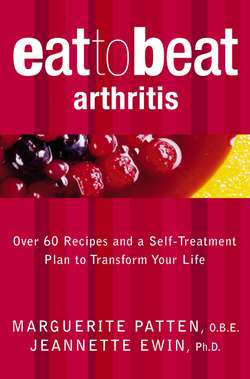Читать книгу Arthritis: Over 60 Recipes and a Self-Treatment Plan to Transform Your Life - Marguerite O.B.E. Patten - Страница 19
Foods that harm
ОглавлениеThings we eat may cause harm in several ways:
Some may contain a toxic substance that, eaten in excess, can create metabolic problems in your body.
Some may trigger an allergic reaction.
Some may cause food sensitivity.
Some may aggravate inflammation.
Here are some examples:
Arthritis sufferers, and people concerned about the health of their bones, should be aware that rhubarb contains oxalic acid, which inhibits the body’s ability to absorb calcium and iron from other foods. (The acid is concentrated in the leaves, which are poisonous and should never be eaten.) Rhubarb aggravates gout and rheumatoid arthritis, and may even cause an attack if eaten in excess. It may also increase the risk of kidney stones in some patients. If you cook rhubarb, do not use aluminium pans, as the acid juice dissolves aluminium from the surface, leaving it in the food for you to eat. Aluminium may be harmful to the body. Rhubarb is not the only plant containing oxalic acid. Smaller amounts are found in spinach, sorrel and chocolate.
Certain foods can trigger an allergic reaction – some people are allergic to nuts, for example. Seafood, especially lobster and prawns, may also cause problems.
This is a good opportunity to talk about the difference between an allergic reaction and food sensitivity (also known as food intolerance). These two conditions are frequently confused.
An allergic reaction is a serious matter that has immediate consequences. It is caused when the body’s immune system has built up antibodies to one or more substances in a particular food. Symptoms include hives (urticaria), severe breathing difficulty, rash, swelling of the tongue and throat, and – in extreme cases – shock and death. Tingling of the lips and mouth after eating a particular food is a sign that an allergy to a particular food may be developing. If you experience such a response to a specific food, obviously it is prudent to avoid it.
Food sensitivity, or intolerance, is far less dramatic, but can cause serious symptoms that may vary from person to person. Migraine headaches, nausea, indigestion, eczema, stomach upset and hyperactivity have all been linked with food sensitivity. Symptoms do not appear with the speed seen in allergic reactions, and it is frequently difficult to identify the exact cause of the problem. In order to identify which food is causing the symptoms, an elimination diet is usually necessary.
For a few days the sufferer is placed on a diet based on foods known to cause little, if any, intolerance. This gives the body time to rid itself of substances that may be causing the problem. Following this rest period, other foods are introduced one at a time. Most will cause no recurrence of symptoms, and thereafter can be safely added to the diet. As more foods are introduced, almost inevitably one new item will cause symptoms to reappear. When this occurs, the culprit (or one of them) has been identified and the person on the exclusion diet will know to avoid that food in the future.
The Eat to Beat Arthritis Diet includes an elimination diet that should help you identify your sensitivity to foods that can trigger, or increase, the painful inflammation of arthritis.
Certain foods known to cause sensitivity are eliminated from the Eat to Beat Arthritis Diet. These are:
